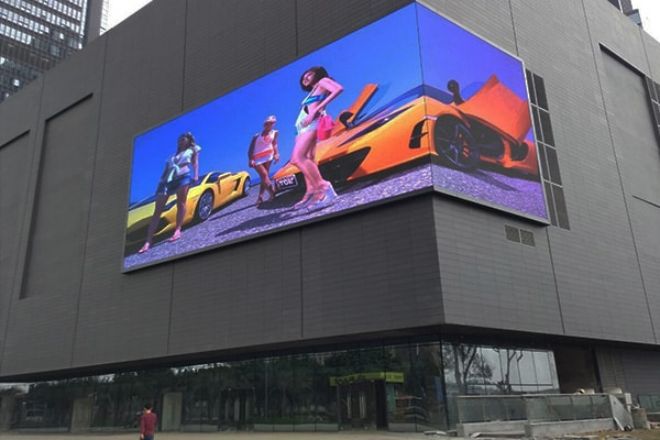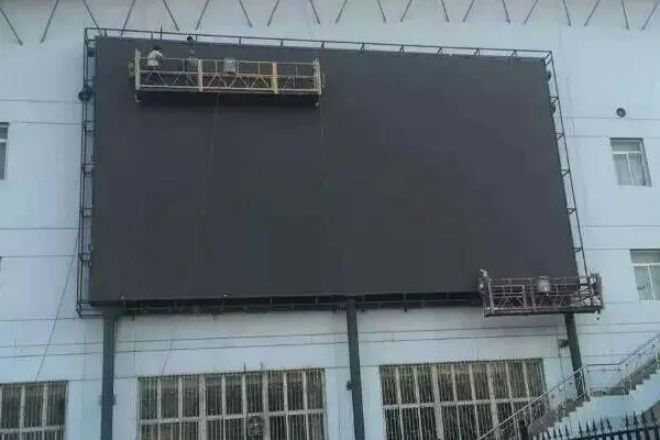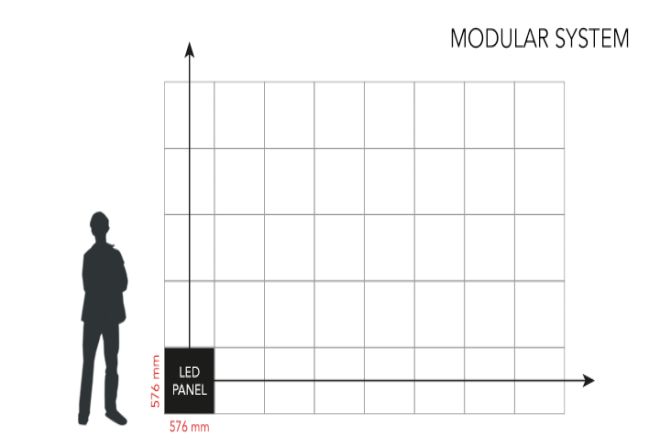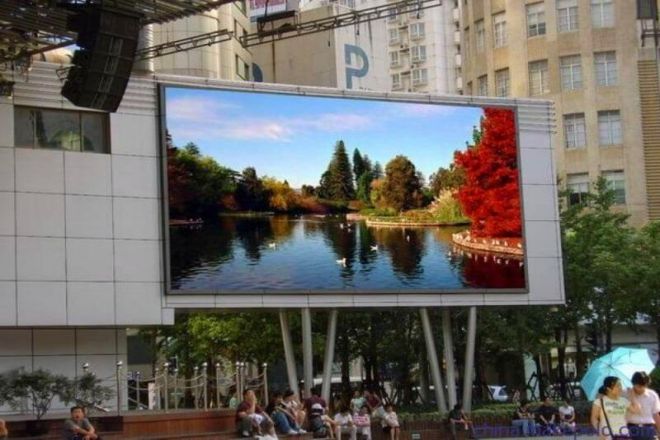مقدمة

في عصرنا الرقمي والمعلوماتي اليوم، شاشات LED خارجية, as an important information dissemination medium, have been widely used in every corner of the city.
Whether it is commercial advertising, public information release, or cultural propaganda, outdoor LED displays have become an important part of the city’s image with their unique advantages, such as high brightness, high definition, and large area coverage.
However, precisely because of its importance, we need to avoid some common misunderstandings when using outdoor LED displays to ensure that they can play the best effect.
1. Misconceptions in selecting the installation location

1). Ignoring environmental factors
Failure to consider wind direction and wind force: When selecting a site, failure to fully consider the local wind direction and wind force conditions may cause the display screen to shake or overturn in strong winds, which will seriously affect the safety and stability of the display screen.
Failure to evaluate direct sunlight: Direct sunlight will not only affect the brightness of the display screen, making it too dazzling at certain times but may also affect the color of the display screen, resulting in color distortion or color shift.
Failure to consider extreme weather: The potential damage to the display screen caused by extreme weather, such as rain, snow, and lightning, cannot be ignored. If the installation location is not properly selected, the display screen may be damaged in extreme weather and even cause safety accidents.
2). Ignore the viewing angle and distance.
The installation position is too high or too low: The installation height of the display screen should be moderate. If it is too high, the audience will find it difficult to see the content clearly. If it is too low, it may cause visual fatigue or affect the viewing experience. Therefore, the viewing distance and angle of the audience should be fully considered during installation.
Ignore the audience mobility: In areas with dense or high mobility, the audience’s viewing angle and position may change constantly. If the installation position of the display screen is fixed and unreasonable, some viewers may not be able to see the complete content, or the effect of information communication may be poor.
3). Blindly pursue a prominent position.
Ignore the coordination with the surrounding environment: In order to attract attention, some users may blindly pursue a prominent position and install the display screen in a place that is inconsistent with the urban landscape or architectural style. This may not only destroy the overall beauty of the city but also cause disgust among residents or tourists.
Failure to consider urban planning and advertising management policies: In some cities or regions, the setting and installation of outdoor advertising must follow specific plans and policies. Ignoring these regulations may lead to illegal installation, which may lead to risks such as fines or demolition. Therefore, you need to fully understand and comply with local regulations and policies before installation.
2. Misunderstandings of content design
1). Monotonous content
Long-term playback of single content: If the outdoor LED display plays the same content for a long time without freshness and change, the audience will easily get bored and lose interest. The content should be diverse and innovative to attract the audience’s attention.
Ignoring the frequency of content updates: The frequency of content updates is equally important. If the content is not updated for a long time, even if the content itself is attractive, the audience will lose interest due to a lack of freshness. Therefore, regularly updating content is the key to keeping the audience’s attention.
2). Improper font and color selection
Too small font or low color contrast: Font size and color contrast are crucial to the audience’s reading experience. Too small fonts or text with low color contrast will make it difficult for the audience to recognize and affect the delivery effect of the information. Therefore, when choosing fonts and colors, you need to ensure that they are clear and easy to read.
Color matching is too fancy: Although bright colors can attract the audience’s attention, too fancy color matching may interfere with the communication of information and make it difficult for the audience to capture key information. Therefore, it is necessary to pay attention to balance and coordination in color matching.
3). Ignoring cultural differences and audience characteristics
Failure to consider the cultural background and aesthetic habits of different audience groups: The audience of outdoor LED displays is wide, including people of different ages and cultural backgrounds. Therefore, the characteristics and preferences of these audiences need to be considered when designing content to ensure that the content resonates with them.
Content design lacks targeting and interactivity: Designing targeted content for different audience groups can increase the audience’s sense of participation and interactivity. For example, some links or activities that interact with the audience can be designed to allow the audience to participate in the content and increase the audience’s participation and satisfaction.
4). Excessive pursuit of advertising effects
Over-emphasis on advertising revenue: Although one of the main functions of outdoor LED displays is advertising, over-emphasis on advertising revenue may cause the content to be too commercialized and lose the trust and goodwill of the audience. When designing content, it is necessary to balance the relationship between advertising effects and brand image.
The content is too commercialized: Overly commercialized content may make the audience feel disgusted and affect their perception and evaluation of the brand or product. Therefore, when designing content, it is necessary to pay attention to the quality and values of the content and avoid excessive commercialization.
3. Misunderstandings in selecting LED screen size

Misunderstandings in selecting LED screen size mainly include the following aspects:
1). Ignoring the installation environment:
- Confusing indoor and outdoor:
LED display screens are divided into indoor and outdoor types. Indoor screens usually have higher requirements for resolution and color reproduction, while outdoor screens require higher brightness and waterproof and dustproof capabilities.
Ignoring the installation environment and using indoor screens for outdoor or vice versa will affect the display effect and service life.
- Insufficient assessment of ambient brightness:
Outdoor LED display screens need to consider ambient brightness so that they can be displayed clearly under different lighting conditions. If the ambient brightness is underestimated, the brightness of the selected display screen may not be enough to display content under strong light.
2). Misunderstanding of dot pitch and resolution:
- Thinking that the smaller the dot pitch, the better:
Although, the smaller the dot pitch (the distance between LED pixels), the more delicate the display effect, too small a dot pitch will increase the cost and may not be suitable for all application scenarios. For example, in situations where viewing is at a long distance, a dot pitch that is too large may be more appropriate.
- A mismatch between resolution and size:
When selecting an LED display screen, it is necessary to ensure that the resolution matches the size to ensure the clarity and quality of the displayed content. Too high or too low a resolution will result in poor display effects.
3). Ignore viewing distance:
- Not considering the optimal viewing distance:
The optimal viewing distance refers to the optimal distance at which the audience can clearly see the content of the display. When choosing an LED display, you need to determine the appropriate size and resolution based on the distance between the audience and the display to ensure the best viewing experience.
- Ignore audience mobility:
In areas with dense traffic or high mobility, the audience’s viewing angle and position may change constantly. Therefore, when choosing the size of the LED display, you need to consider the audience’s mobility to ensure that you can get a good viewing effect at different positions and angles.
4). Misunderstandings of budget and cost performance:
- Blindly pursuing low prices:
Although price is one of the factors that need to be considered when choosing an LED display, blindly pursuing low prices may lead to the selection of poor quality products, affecting the display effect and service life.
- Ignore cost performance:
When choosing an LED display, you need to consider multiple factors such as price, performance, quality, and after-sales service to find the most cost-effective product.
5). Ignore brand and after-sales service:
- Ignore brand strength:
Well-known brands usually have better product quality and a more complete after-sales service system. Therefore, when choosing an LED display, you need to consider brand strength to avoid choosing inferior products.
- Not understanding after-sales service:
Good after-sales service can ensure that problems can be solved in time when they occur. Therefore, when choosing an LED display, you need to understand the manufacturer’s after-sales service policy and service quality.
4. Other misunderstandings

1). Ignoring maintenance
- Not formulating a regular maintenance plan:
The service life and performance of an LED display are closely related to its maintenance. Ignoring regular maintenance, such as cleaning the screen, checking the connection wires, tightening the screws, etc., will cause the performance of the display to gradually decline, such as reduced brightness and color distortion.
Reference information shows that a reasonable maintenance plan can significantly extend the service life of the LED display while maintaining the stability and reliability of its display effect.
- Failure to handle display failures in a timely manner:
When an LED display fails, such as power problems, display abnormalities, etc., if not handled in time, it will not only affect the display effect but may also further damage the hardware equipment of the display.
Timely handling of display failures, such as immediately cutting off the power and calling maintenance personnel, can minimize the damage to the display caused by the failure and ensure the normal use of the display.
2). Ignoring energy conservation and environmental protection
- Ignoring the energy consumption of the display:
Although the LED display has the characteristics of high efficiency and energy saving, it is still necessary to pay attention to its energy consumption during use. Long-term operation and high brightness will increase the energy consumption of the display screen and cause energy waste.
Through reasonable brightness adjustment, timed on/off, and other measures, the energy consumption of LED display screens can be effectively reduced to achieve energy conservation and environmental protection.
- No environmentally friendly materials and technologies are used:
In the process of production and use, the use of environmentally friendly materials and technologies is crucial to reducing the impact of LED display screens on the environment. Some LED display screens may use harmful substances in the production process, which has a negative impact on the environment.
Choosing LED display screens produced with environmentally friendly materials and technologies, such as using environmentally friendly materials such as lead-free and halogen-free, and using environmentally friendly technologies such as energy-saving and low-consumption, can significantly reduce the impact of LED display screens on the environment and achieve green and sustainable development.
خاتمة
Through the analysis of misunderstandings in the selection of installation locations and the design of playback content of outdoor LED display screens, it is not difficult to find that avoiding these misunderstandings is crucial to improving the use effect of the display screen.
Only by scientifically and rationally carrying out installation and maintenance and carefully designing the playback content can we ensure that the outdoor LED display screen can play the greatest value in urban information dissemination.
وأخيرًا، إذا كنت تريد معرفة المزيد عن شاشات العرض LED، يرجى الحصول على اتصال معنا.
